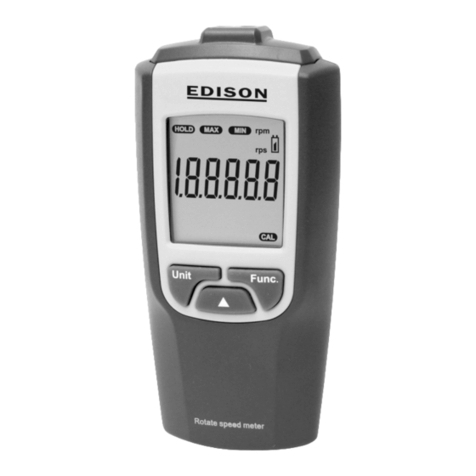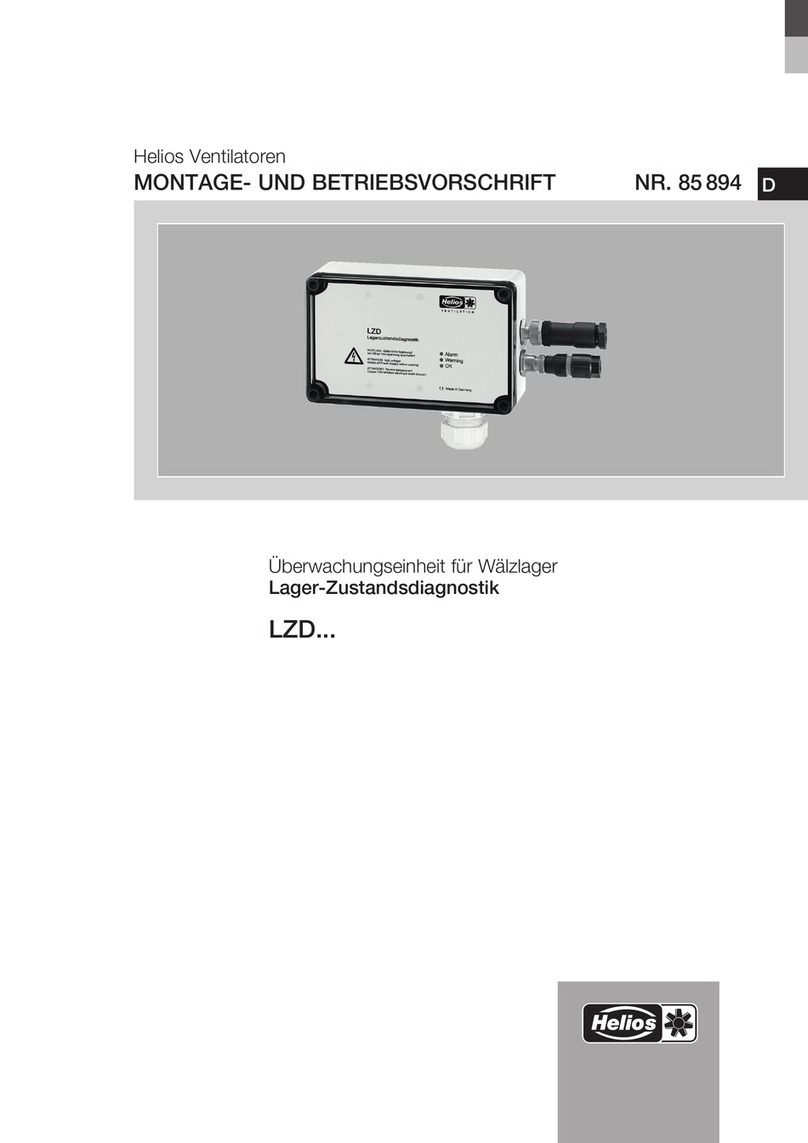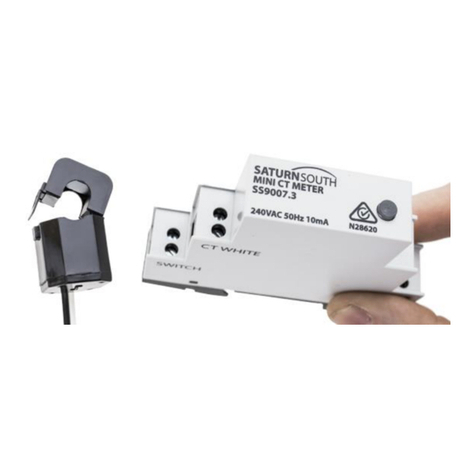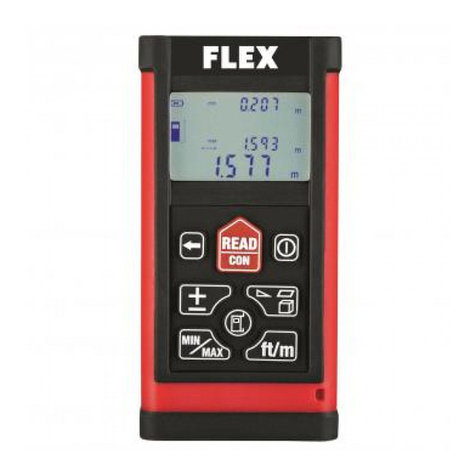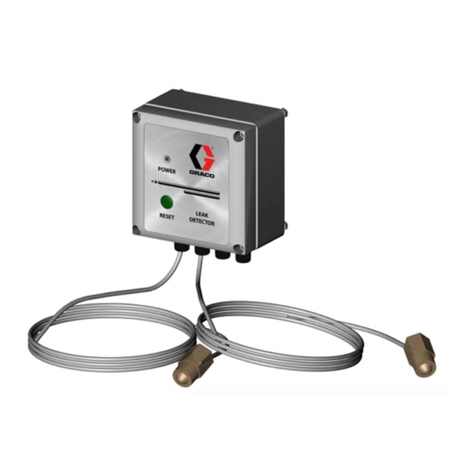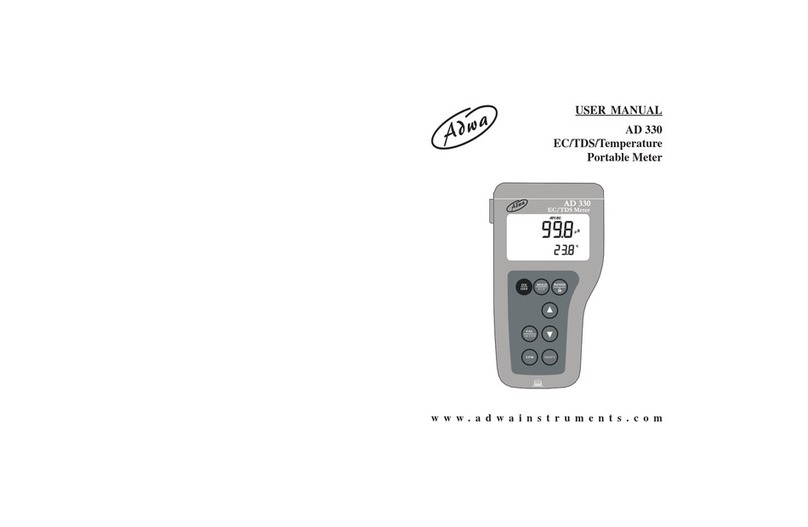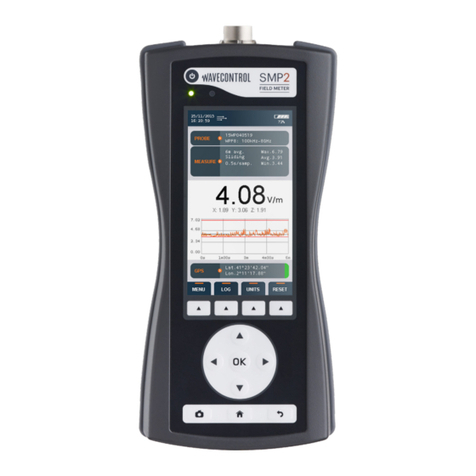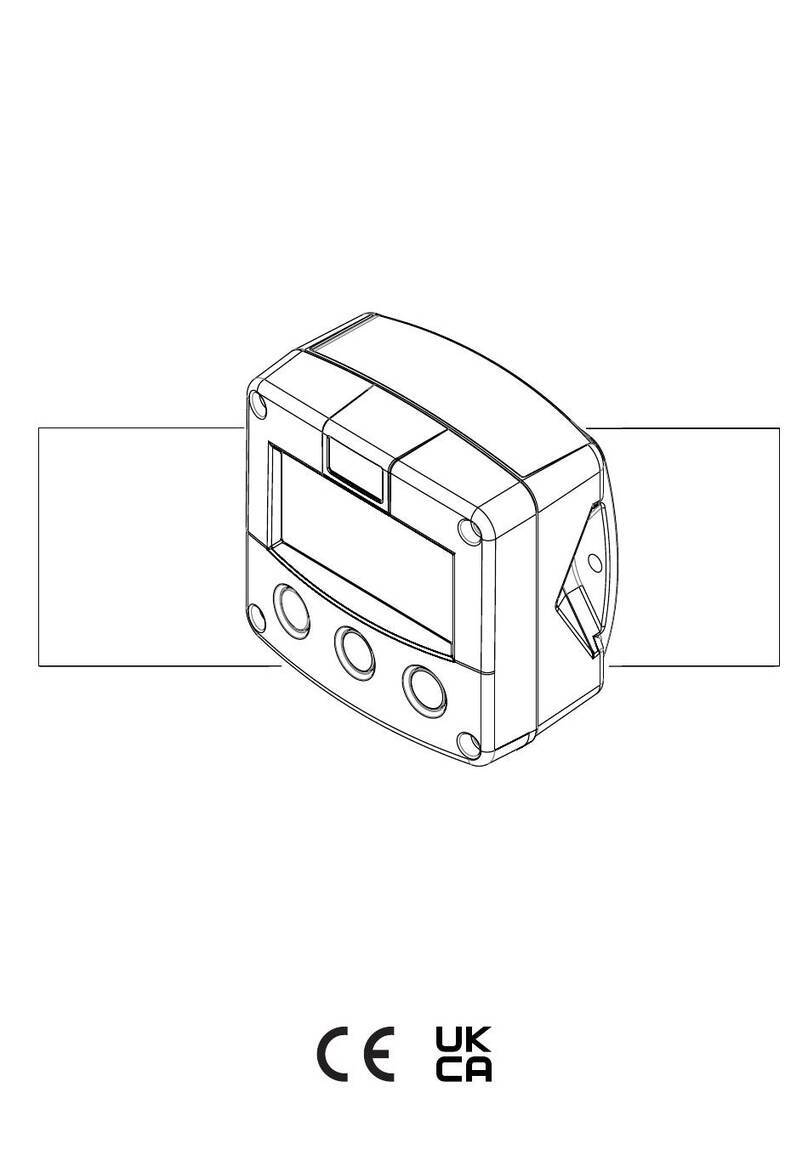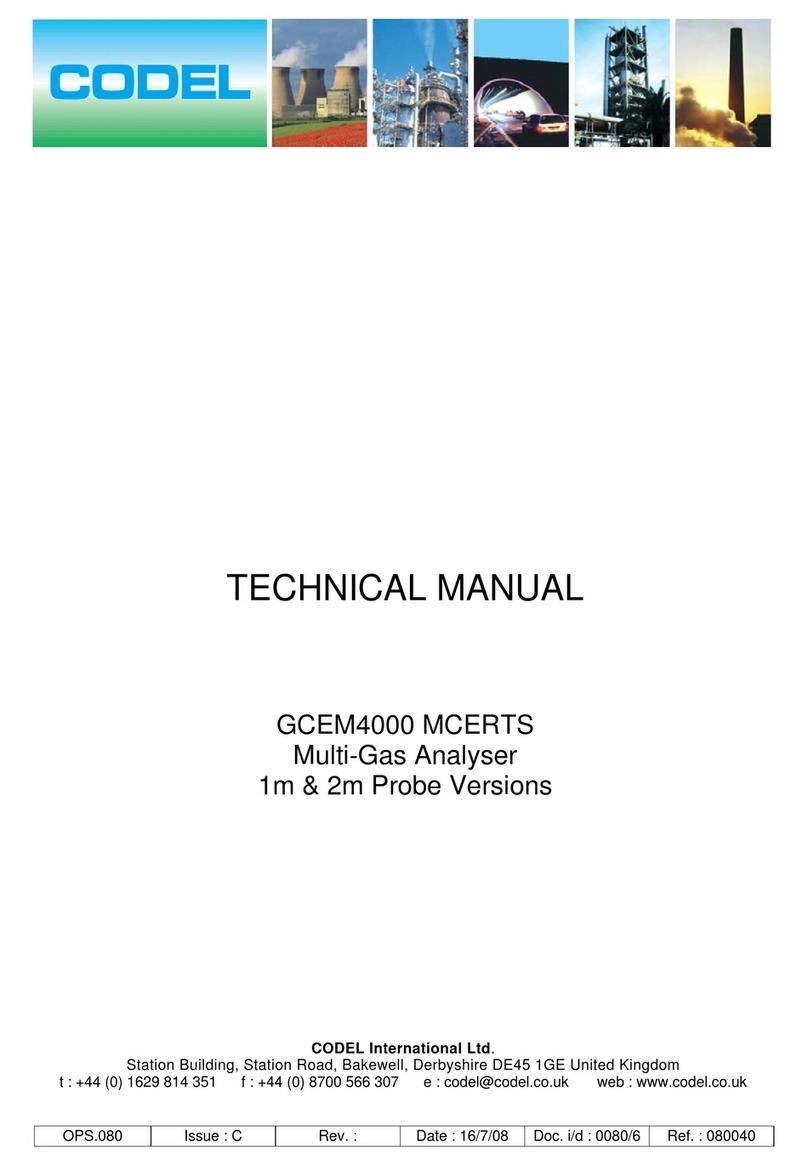Edison DCM007 User manual

Auto Range Digital Clamp Meter
- True RMS 1000A AC/DC
OPERATING MANUAL
FFuunnccttiioonnss
•TTeelleepphhoonneenneettwwoorrkktteessttiinngg..
•FFuusseeccoonnnneeccttiioonntteessttiinngg..
ORDER CODE: EDI-516-3840K
MODEL DCM007
5163840K_Instructions.qxd 22/09/2009 08:45 Page 1

2
CONTENT
1. SAFETY INFORMATION .......................................................................................... 2
2. GENERAL DESCRIPTION ........................................................................................ 4
3. DESCRIPTION.......................................................................................................... 4
4. OPERATING INSTRUCTIONS .................................................................................. 6
5. SPECIFICATIONS .................................................................................................... 9
6. MAINTENANCE...................................................................................................... 12
7. PACK CONTENT .................................................................................................... 13
1.
GENERAL INSTRUCTIONS
The digital clamp meter has been designed according to IEC1010-1 and
IEC1010-2-032 concerning safety requirements for electrical measuring
instruments and hand-held current clamps with double insulation overvoltage
category 1000V CAT II 600V CAT III and pollution 2.
This meter complies with the requirements of the following European community
directives:
89 / 336 / EEC (Electromagnetic Compatibility) and 73 / 23 / EEC (Low Voltage)
as amended by 93 / 68 / EEC (CE Marking).
However, electrical noise or intense electromagnetic fields in the vicinity of the
equipment may disturb the measurement circuit.
Measuring instruments will also respond to unwanted signals that may be
present within the measurement circuit.
Users should exercise care and take appropriate precautions to avoid misleading.
1.1. Safety Precautions
• When using this multimeter, the user must observe all normal safety rules
concerning:
- Protection against the dangers of electric current.
- Protection of the multimeter against misuse.
• For your own safety, only use the test probes supplied with the multimeter provided.
• When the meter is delivered, check that it has not been damaged in transit.
If any part of the kit has been damaged, contact your dealer and DO NOT use
the meter.
• DO NOT touch unused terminals when meter is linked to a circuit.
• DO NOT measure voltage if the voltage on the terminals exceeds 600V above
earth ground.
5163840K_Instructions.qxd 22/09/2009 08:45 Page 2

3
Auto Range Digital Clamp Meter - True RMS 1000A AC/DC
• Follow all safety and operating instructions to ensure maximum personal
safety during the operation and to ensure the meter is used safely and is kept
in good operating condition.
• Read the operating instructions thoroughly and completely before operating
your meter.
• Pay attention to WARNINGS, which will inform you of potentially dangerous
procedures. The instructions in these warnings MUST be followed.
• Always inspect your meter and test leads for any sign of damage or
abnormality before every use. If any abnormal conditions exist (i.e. broken test
leads, cracked cases, display not reading, etc.). DO NOT attempt to take any
measurements.
• Please DO NOT store or use meter in areas exposed to direct sunlight, high
temperature, humidity or condensation.
• Never ground yourself when taking electrical measurements. Keep your body
isolated from ground by using dry clothing, rubber shoes, rubber mat or any
approved insulating material.
• Be careful when working with voltages above 60V DC or 30V AC rms. Keep
fingers behind the probe barriers while measuring.
• To avoid damages to the instrument, NEVER exceed the maximum limits of the
input values shown in the technical specification tables.
• Never use the meter to measure voltages that might exceed the maximum
allowable input value of any function.
• Never touch exposed wiring, connections or any live circuit when attempting
to take measurements.
• Before rotating the range selector to change functions or opening the battery
case, ALWAYS disconnect test leads from the circuit under test.
• Never use the meter unless the back cover is in place and fastened completely.
• Do not use abrasives or solvents on the meter. To clean it using a damp (not
wet) cloth and mild detergent only.
• Qualified and trained service technicians should only perform calibration and
repair of the meter.
1.2. Symbols
Important safety information, refer to the operating manual.
Dangerous voltage may be present.
Earth ground.
Double insulation (Protection class 1000V CAT II 600V CAT III).
5163840K_Instructions.qxd 22/09/2009 08:46 Page 3

1.3. Maintenance
• Never touch exposed wiring, connections or any live circuit when attempting to
take measurements.
• Before opening the case, always disconnect test leads from all energised
circuits.
• Never use the meter unless the back cover is in place and fastened
completely.
• Do not use abrasives or solvents on the meter. To clean it using a damp cloth
and mild detergent only.
• Qualified and trained service technicians should only perform calibration and
repair of the meter.
2.
GENERAL DESCRIPTION
The meter is an auto range professional clamp meter with 3999 counts. For
measuring DC and AC voltage, DC and AC current, Resistance, Frequency,
Frequency for the clamp, Diode, and Continuity Test with battery operated.
There is the AC measurement to be RMS or TRUE RMS about the meter. It is
chosen as user buy.
3.
DESCRIPTIONS
•TTrraannssffoorrmmeerrJJaawwss- Pick up DC or AC current flowing through the conductor.
•RRiiggggeerr(clamp lever) - Press the lever to open the transformer. When the
lever is released, the jaws will close again.
•RRoottaarryyddiiaall- Used to select functions.
•FFUUNNCC..button - In ΩΩrange on the dial, press this ‘FUNC’ button to select
one of these function (Resistance ΩΩ, Continuity or Diode ). The chosen
symbol will appear on the LCD screen.
•ZZEERROObutton - Push this button to show the relative measurement mode, ‘REL’
annunciate display on LCD. Store the displayed reading as a reference value. In
the relative mode, the value shown on the LCD is always the difference
between the stored reference value and the present reading. If the new
reading is the same as the reference value, the display will be zero.
•MMAAXX//MMIINNbutton - Press the key to enter the MAX/MIN recording hold mode.
The maximum, minimum values are then reset to the present input. The
readings are stored in memory. 'MAX' or 'MIN' annunciator turns on to indicate
what value is being displayed. Hold this button for more than 3 seconds to
return to the normal operating mode.
4
5163840K_Instructions.qxd 22/09/2009 08:46 Page 4

5
Auto Range Digital Clamp Meter - True RMS 1000A AC/DC
•HHOOLLDDbutton - When this button is pushed,
the display will keep the last reading and
‘ ‘ symbol will appear on the LCD.
Pushing it again returns the meter to
normal mode.
•''CCOOMM''jack - This is negative (ground)
input terminal for all measurements
except current. Connection is made to
it using the black test lead.
•''VVΩΩHHzz''jack - This is positive
input terminal for volt, resistance
frequency, diode and Continuity
test. Connection is made to it
using the red test lead.
• button - Backlight. Press this
button to turn ‘ON’ the LCD backlight,
after 5 seconds the backlight will
automatically turn off. To turn the
backlight on again, just press it
once more.
•LLCCDDddiissppllaayy
5163840K_Instructions.qxd 22/09/2009 08:46 Page 5

6
4.
OPERATING INSTRUCTIONS
4.1. CURRENT
AC Current Measurement
1. Set the rotary dial to ‘AA~~’ position (default auto range).
2. Press ‘ZZEERROO’ button to enter the zero mode (manual range).
3. Press the trigger to open transformer jaw and to clamp one conductor only,
making sure that the jaw is firmly closed around the conductor.
4. Read the measure result from the display.
NNOOTTEE::
• Make certain that all test leads are disconnected from the meter terminals.
• Open and close the clamp jaw several times to demagnetise the clamp jaw
before taking any DC current measurement.
DC Current Measurement
1. Set the rotary dial at ‘AA’ position (default auto range).
2. Press ‘ZZEERROO’ button to enter the zero mode (manual range).
3. Press the trigger to open transformer jaw and to clamp one conductor only,
making sure that the jaw is firmly closed around the conductor.
4. Read the measure result from the display.
NNOOTTEE::
• Make certain that all test leads are disconnected from the meter terminals.
• Open and close the clamp jaw several times to demagnetise the clamp jaw
before taking any DC current measurement.
4.2. VOLTAGE
DC Voltage Measurement
1. Insert the black test leads into the CCOOMMand red in to the VVΩΩHHzzinput terminals
respectively.
2. Set rotary dial at desired ‘VV’ position (default auto range).
3. Connect the test lead tips in parallel with the circuit to be measured. Be
careful not to touch any electrical conductors.
4. The polarity of the red lead connection will be indicated along with the voltage value.
5. Read the measure result from the display.
5163840K_Instructions.qxd 22/09/2009 08:46 Page 6

7
Auto Range Digital Clamp Meter - True RMS 1000A AC/DC
4.3. AC Voltage Measurement
1. Insert the black test leads into the CCOOMMand red into the VVΩΩHHzzinput terminals
respectively.
2. Set rotary dial at desired ‘VV~~’ position (default auto range).
3. Connect the test lead tips in parallel with the circuit to be measured. Be
careful not to touch any electrical conductors.
4. Read the measure result from the display.
4.4. Resistance Measurement
1. Insert the black and red test leads into the CCOOMMand VVΩΩHHzzinput terminals
respectively.
2. Set rotary dial at desired ΩΩposition.
3. The LCD will automatically select the ΩΩ(default) symbol.
4. Connect the test lead tips in parallel with the resistance in the circuit being
measured.
5. Read the measure result from the display.
NNOOTTEE::
• If the resistance being measured exceeds the maximum value of the range or
the input is not connected, an overrange indication ‘OL’ will be display.
• When checking in-circuit resistance, be sure the circuit under test has all
power removed and that all capacitors have been discharged fully.
4.5. Continuity Testing
1. Insert the black and red test leads into the CCOOMMand VVΩΩHHzzinput terminals
respectively.
2. Set rotary dial at desired ΩΩposition (default auto range).
3. Push ‘FFUUNNCC..’ button once to select (manual range).
4. Connect the test lead tips in parallel with the resistance in the circuit being
measured. If continuity exists (i.e. resistance less than 40Ω) built - in buzzer
will sound.
4.6. Diode Testing
1. Insert the black and red test leads into the CCOOMMand VVΩΩHHzzinput terminals
respectively.
2. Set rotary dial at desired ΩΩposition (default auto range).
3. Push ‘FFUUNNCC..’ button twice to select (manual range). The red leaded probe
should then be connected to the anode and the black leaded probe to the
cathode of the diode.
5163840K_Instructions.qxd 22/09/2009 08:46 Page 7

8
4. The typical voltage drop should be about 0.6V for silicon diode or 0.3V for
germanium diode. If the diode is reverse biased or there is an open circuit the
reading displayed will be ‘OL’.
4.7. Frequency Measurement
1. Insert the black and red test leads into the CCOOMMand VVΩΩHHzzinput terminals
respectively.
2. Set the rotary dial to ‘HHzz’ position (default auto range).
3. Connect the test leads across the source or load under measurement. The
polarity of the red lead connection is positive ‘+’.
4. Read the measure result from the display.
NNOOTTEE::
• The signal amplitude must also be greater than the sensitivity level.
• Determine that the amplitude level of the signal to be measured is not greater
than the input voltage limit.
4.8. Measuring Frequency From Clamp
1. Set the rotary dial to HHzzposition (default auto range).
2. Press the trigger to open transformer jaw and to clamp one conductor only,
making sure that the jaw is firmly closed around the conductor.
3. Read the measure result of frequency of AC current flowing through the
transformer jaw from the display.
NNOOTTEE::
• Frequency range: 40Hz to 400Hz (> 20A ).
c
5163840K_Instructions.qxd 22/09/2009 08:46 Page 8

9
Auto Range Digital Clamp Meter - True RMS 1000A AC/DC
5.
SPECIFICATIONS
5.1. Accuracy
• ±% of reading ±number of least significant digits at 18°C to 28°C, with
relative humidity up to 75%.
• All specifications assume less than 1 year since calibration. Temperature
coefficient:
• 0.1x specified accuracy/°C.
5.2. General
• Maximum voltage: 1000V CAT II 600V CAT III
• Altitude: 2000m
• Display: LCD 3999 counts
Updates 2-3/sec
• Ranging method: Auto/manual range mode
• Polarity indication: ‘__’ display for negative polarity
• Overrange indication: LCD will display ‘OL’
• Low battery: ‘ ‘ will appears on LCD
• Jaw capability: 40mm, Max conductor size
• Power: Battery 1.5V x3 Size AAA
• Size: 225mm x 86mm x 32mm
• Operating: 5°C to 35°C
• Storage temperature: 10°C to 50°C
5.3. VOLTAGE
DC Voltage
• Input Impedance: 10MΩ.
• Overload Protection: 1000V DC or 700V AC RMS
RANGE RESOLUTION ACCURACY
4V 1mV
40V 10mV ±(0.8% of rdg +5 digits)
400V 0.1V
600V 1V ±(1.0% of rdg +5 digits)
1000V 1V
5163840K_Instructions.qxd 22/09/2009 08:46 Page 9

10
AC Voltage
• Input Impedance: 10MΩ.
• Frequency range: 40Hz to 400Hz
• Overload Protection: 1000V DC or 700V AC RMS
5.4. CURRENT
DC Current
• Overload Protection: 120% ranges for 60 seconds max
AC Current
• Frequency range: 50Hz to 60Hz
• Overload Protection: 120% ranges for 60 seconds max
5.5. Resistance
RANGE RESOLUTION ACCURACY
400A 0.1A ±(3.0% of rdg +5 digits)
600A 1A
1000A 1A ±(3.0% of rdg +6 digits)
RANGE RESOLUTION ACCURACY
400A 0.1A ±(2.5% of rdg +5 digits)
600A 1A
1000A 1A ±(3.0% of rdg +6 digits)
RANGE RESOLUTION ACCURACY
400Ω0.1Ω
4kΩ1Ω
40kΩ10Ω±(1.0% of rdg +5 digits)
400kΩ0.1kΩ
4MΩ1kΩ
40MΩ10kΩ±(2.0% of rdg +6 digits)
RANGE RESOLUTION ACCURACY
4V 1mV
40V 10mV ±(1.2% of rdg +5 digits)
400V 0.1V
600V 1V ±(2% of rdg +5 digits)
700V 1V
5163840K_Instructions.qxd 22/09/2009 08:46 Page 10

11
Auto Range Digital Clamp Meter - True RMS 1000A AC/DC
• Overload Protection: 250V dc or rms, ac for all ranges
5.6. Frequency
• Measurement range: 1V to 10V rms, 40Hz to 100kHz
5.7. Frequency Measured with Clamp
5.8. Audible Continuity and Diode
5.9. Auto Power Off
To extend the battery life 'Auto Power Off' function is provided. If no function
changes occur after about 30 minutes, the meter will be turned 'off'
automatically. To turn the power back 'On', push the ‘FFUUNNCC’. button only.
RANGE RESOLUTION ACCURACY
40Hz 0.01Hz ±(0.1% of rdg +1 digit)
400Hz 0.1Hz
RANGE DESCRIPTION
If continuity exists (about less than 40 ),
built-in buzzer will sound.
Show the approx. Forward voltage of the diode.
RANGE RESOLUTION ACCURACY
40Hz 1Hz
400Hz 1Hz
4kHz 10Hz ±(0.1% of rdg +1 digit)
40kHz 100Hz
100kHz 100Hz
5163840K_Instructions.qxd 22/09/2009 08:46 Page 11

12
6.
MAINTENANCE
6.1 General Maintenance and Cleaning
To avoid electrical shock or damage to the multimeter, do not get
water inside the case. Remove the test leads and any input signals
before opening the case.
Cleaning the multimeter:
• Wipe the case with a soft damp (not wet) cloth and mild detergent.
• DO NOT use abrasive or solvents.
• Dirt or moisture in the terminals can affect readings.
Cleaning the terminals:
• Turn the meter off and remove all test leads.
• Shake out any dirt that may have gathered in the terminals.
• Soak a clean swab or cotton bud with a cleaning and oiling agent (such as WD-40).
• Work the swab/bud around in each terminal until you are happy there
are clean. The oiling agent insulates the terminals from moisture-related
contamination.
Before replacing the battery and fuses, disconnect test leads from
any circuit under test, turn the multimeter 'OFF' and remove test
leads from the input terminals.
To prevent damage to the meter or personal injury, always replace
the battery or fuse with specified rating.
6.2 Battery replacement
When the battery voltage drops below a usable operation range the symbol will
appear on the LCD display, this indicates that the battery supply will need
replacing. To do this you will need to do the following steps.
• Set the meter to 'OFF' state.
• Disconnect test leads from any inputs terminals.
• Use the appropriate screwdriver to unscrew the secured back cover. This will
expose the batteries.
• Replace the battery with 1.5V x3 new AAA batteries.
• Replace the battery cover and screw securely back into place.
• The multimeter should now be fully functional.
5163840K_Instructions.qxd 22/09/2009 08:46 Page 12

13
Auto Range Digital Clamp Meter - True RMS 1000A AC/DC
6.3 Fuse replacement
• Set the meter to 'OFF' state.
• Disconnect test leads from any inputs terminals.
• Use the appropriate screwdriver to unscrew the secured back cover and then
the battery cover.
• Replace the 2 back covers and screw securely back into place.
• The multimeter should now be fully functional.
CAUTION
Please be aware that using the clamp meter in an environment
with a strong radiated radio-frequency electromagnetic field
(approx. 3V/m) may influence the meters measuring accuracy.
7.
PACK INCLUDES
• Digital clamp Multimeter
• Test probes
• 3x DC1.5V AAA batteries (installed)
• Instruction manual
• Protective case with carry strap
5163840K_Instructions.qxd 22/09/2009 08:46 Page 13

14
NOTES
5163840K_Instructions.qxd 22/09/2009 08:46 Page 14

15
Auto Range Digital Clamp Meter - True RMS 1000A AC/DC
5163840K_Instructions.qxd 22/09/2009 08:46 Page 15

Edison Products are continuously being developed and improved.
All details and illustrations are for guidance and may be subject to change.
EDISON
The Power Factory, PO Box 14, Wigston, Leicester, England.
ISO 9001 Registered Company
5163840K_Instructions.qxd 22/09/2009 08:46 Page 16
Table of contents
Other Edison Measuring Instrument manuals
Popular Measuring Instrument manuals by other brands
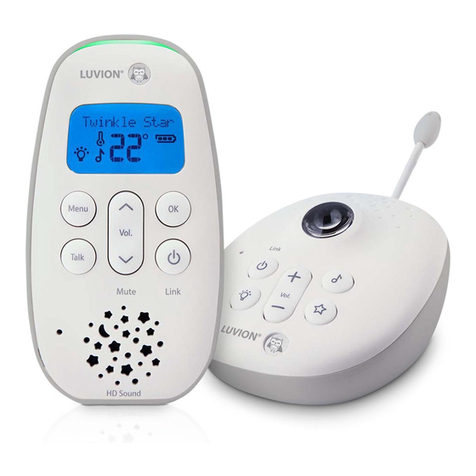
Luvion
Luvion 75 PRO instruction manual
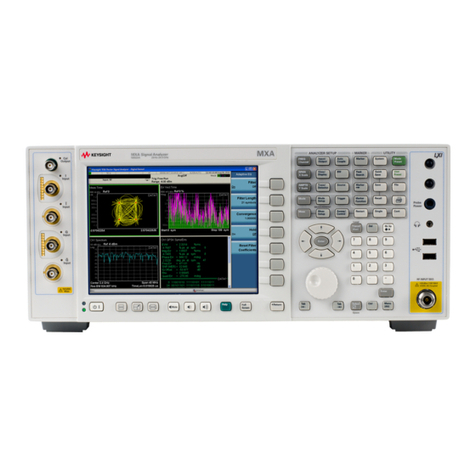
Keysight
Keysight x series manual
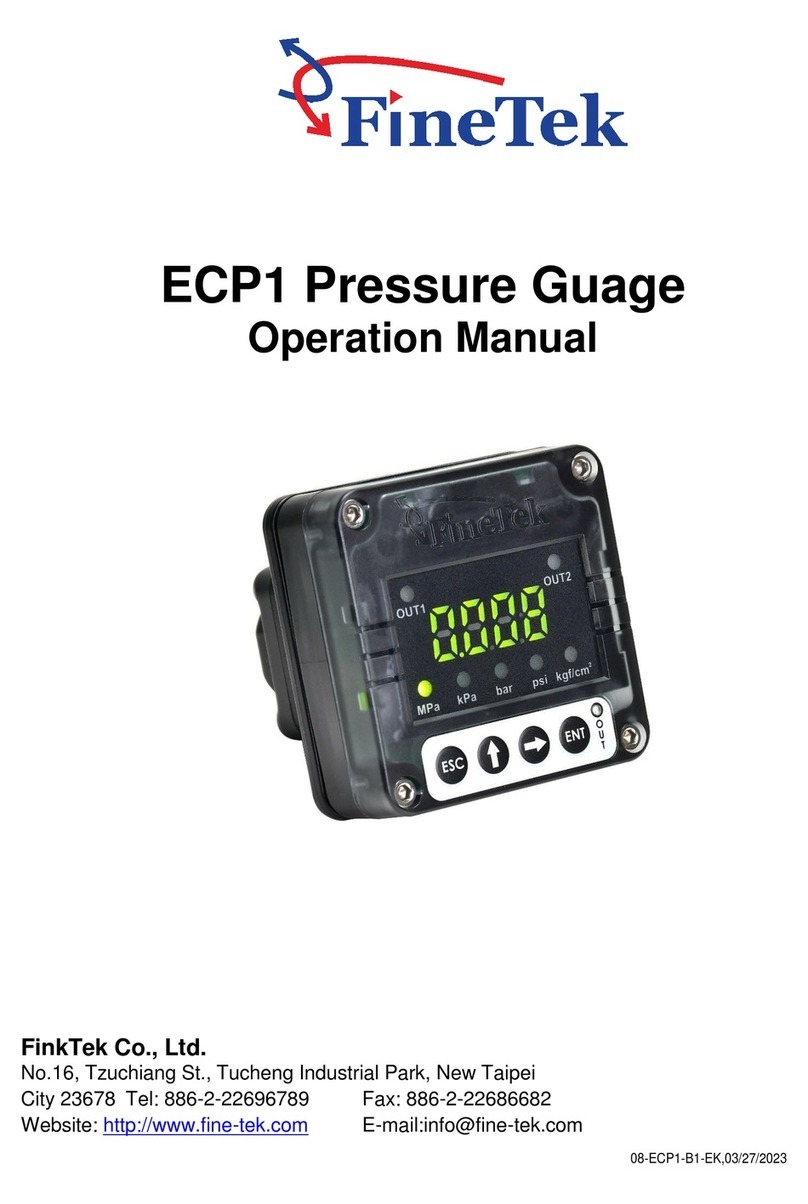
FineTek
FineTek ECP1 Operation manual
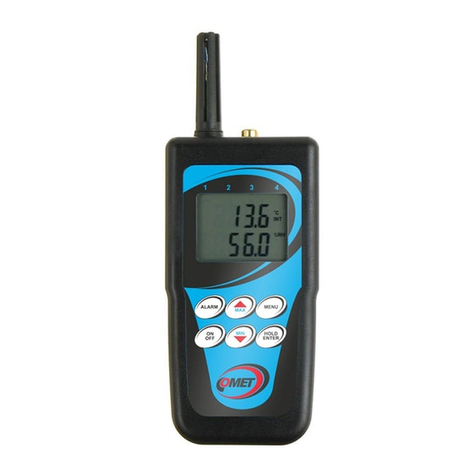
Comet
Comet COMMETER C3631 instruction manual
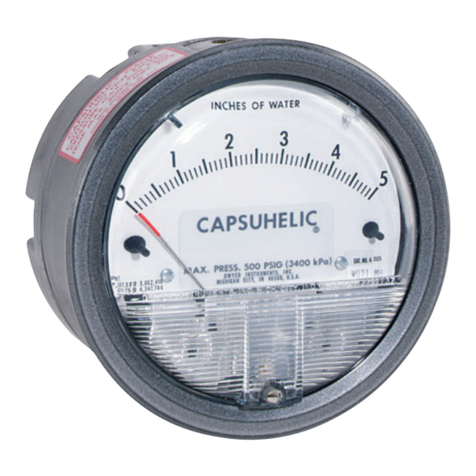
Dwyer Instruments
Dwyer Instruments Capsuhelic 4000-0 Installation and operating instructions
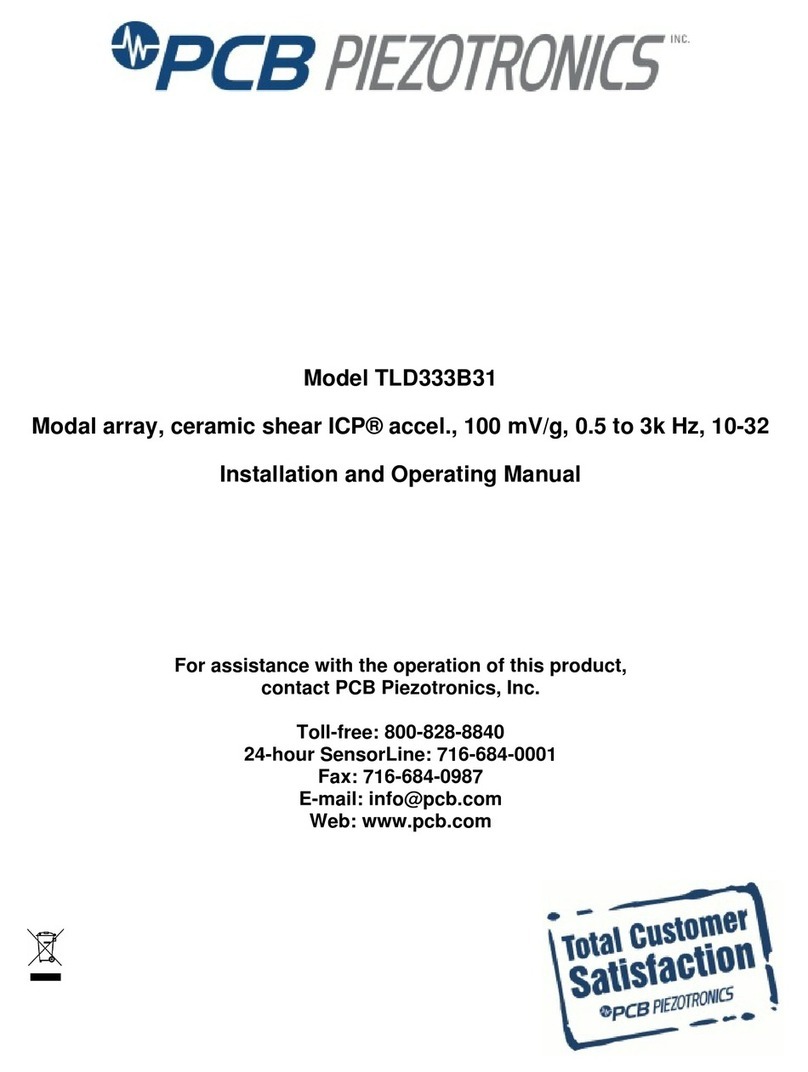
PCB Piezotronics
PCB Piezotronics ICP TLD333B31 Installation and operating manual


